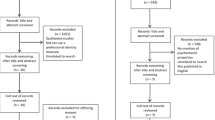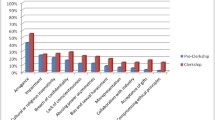Abstract
Objective
This study assessed changes in professional identity, wellness, imposter phenomenon, and calling to medicine over time in medical school.
Methods
Medical students from the first through third years anonymously completed four validated measures: Perceived Wellness Survey (PWS), Brief Calling Scale (BCS), Physician In-group Identification Scale (PID), and Clance’s Imposter Phenomenon Scale (CIP). Survey completion implied informed consent. The study was exempted by the university IRB.
Results
All class of 2018 students (n = 110) returned surveys at the beginning of year 1; 58 completed surveys at the end of the preclinical years (post year 2, n = 44) and/or end of the third-year clerkship (post year 3, n = 35) and were analyzed. From pre to post preclinical years, there was a significant decrease in the PID. There were no statistically significant changes in the PWS, BCS, and CIP. From pre year 1 to post third-year clerkships, the PWS and PID decreased, the CIP increased, and the BCS did not change. Only 19% of students participated in all three survey administrations and this group was excluded from the analysis due to the low response rate.
Conclusion
Student wellness and sense of professional identity (in-group identity) dropped over 3 years of medical education, while imposter phenomenon increased. The BCS did not change over time. The decrease in identity as part of the physician community is concerning; future curriculum initiatives should focus on integration of professional identity into students’ individual identities and on initiatives to improve student well-being.
Similar content being viewed by others
References
Epstein RM, Krasner MS. Physician resilience: what it means, why it matters and how to promote it. Acad Med. 2013;88:301–3.
Wald HS, Anthony D, Hutchinson TA, Liben S, Smilovitch M, Donato AA. Professional identity formation in medical education for humanistic, resilient physicians: pedagogic strategies for bridging theory to practice. Acad Med. 2015;90(6):753–60. https://doi.org/10.1097/ACM.0000000000000725.
Royal College of Physicians of London. Doctors in society: medical professionalism in a changing world. London, UK: Royal College of Physicians of London; 2055.
Cruess RL, Cruess SR, Boudreau JD, Snell L, Steinert Y. Reframing medical education to support professional identity formation. Acad Med. 2014;89(11):1446–51.
Dyrbye LN, Thomas MR, Shanafelt TD. Systematic review of depression, anxiety, and other indicators of psychological distress among U.S. and Canadian medical students. Acad Med. 2006;81(4):354–73. https://doi.org/10.1097/00001888-200604000-00009.
Brazeau CMLR, Schroeder R, Rovi S, Boyd L. Relationships between medical student burnout, empathy, and professionalism climate. Acad Med. 2010;85(10):S33–6. https://doi.org/10.1097/ACM.0b013e3181ed4c47.
McNeill KG, Kerr A, Mavor KI. Identity and norms: the role of group membership in medical student wellbeing. Perspect Med Educ. 2014;3(2):101–12. https://doi.org/10.1007/s40037-013-0102-z.
Duffy RD, Allan BA, Bott EM, Dik BJ. Does the source of a calling matter? External summons, destiny, and perfect fit. J Career Assess. 2014;22(4):562–74. https://doi.org/10.1177/1069072713514812.
Dik BJ, Duffy RD. Calling and vocation at work: definitions and prospects for research and practice. Couns Psychol. 2009;37(3):424–50.10.
Yoon JD, Daley BM, Curlin FA. The association between a sense of calling and physician well-being: a national study of primary care physicians and psychiatrists. Acad Psychiatry. 2017;41(2):167–73. https://doi.org/10.1007/s40596-016-0487-1.
Jager AJ, Tutty MA, Kao AC. Association between physician burnout and identification with medicine as a calling. Mayo Clin Proc. 2017;92(3):415–22. https://doi.org/10.1016/j.mayocp.2016.11.012.
Goodin JB, Duffy RD, Borges NJ, Ulman CA, D’Brot VM, Manuel RS. Medical students with low self-efficacy bolstered by calling to medical speciality. Perspect Med Educ. 2014;3(2):89–100. https://doi.org/10.1007/s40037-014-0110-7.
Borges NJ, Manuel RS, Duffy RD. Speciality interests and career calling to medicine among first-year medical students. Perspect Med Educ. 2013;2(1):14–7. https://doi.org/10.1007/s40037-012-0037-9.
Clance PR, O’Toole MA. The imposter phenomenon: an internal barrier to empowerment and achievement. Women Ther. 1987;6(3):51–64. https://doi.org/10.1300/J015V06N03_05.
Henning K, Ey S, Shaw D. Perfectionism, the impostor phenomenon and psychological adjustment in medical, dental, nursing and pharmacy students. Med Educ. 1998;32(5):456–64.
Villwock JA, Sobin LB, Koester LA, Harris TM. Impostor syndrome and burnout among American medical students: a pilot study. Int J Med Educ. 2016;7:364–9. https://doi.org/10.5116/ijme.5801.eac4.
Harari MJ, Waehler CA, Rogers JR. An empirical investigation of a theoretically based measure of perceived wellness. J Couns Psychol. 2005;52(1):93–103.
Dik BJ, Eldridge BM, Steger MF, Duffy RD. Development and validation of the calling and vocation questionnaire (CVQ) and brief calling scale (BCS). J Career Assess. 2012;20(3):242–63.
Leach CW, van Zomeren M, Zebel S, Vliek MLW, Pennekamp SF, Doosje B, et al. Group-level self-definition and self-investment: a hierarchical (multicomponent) model of in-group identification. J Pers Soc Psychol. 2008;95(1):144–65. https://doi.org/10.1037/0022-3514.95.1.144.
Chrisman SM, Pieper WA, Clance PR, Holland CL, Glickauf-Hughes C. Validation of the Clance imposter phenomenon scale. J Pers Assess. 1995;65(3):456–67.
Pratt MG, Rochman KW, Kaufman Jerry B. Constructing professional identity: the role of work and identity learning cycles in the customization of identity in medical residents. Acad Manag J. 2006;49(2):235–62.
Parkman A. The imposter phenomenon in higher education: incidence and impact. J High Educ Theory Pract. 2016;16(1):51–60.
Duffy RD, Manuel RS, Borges NJ, Bott EM. Calling, vocational development, and well being: a longitudinal study of medical students. J Vocat Behav. 2011;79(2):361–6.
Author information
Authors and Affiliations
Corresponding author
Ethics declarations
Conflict of Interest
The authors declare that they have no conflict of interest.
Ethical Approval
All procedures performed in studies involving human participants were in accordance with the ethical standards of the institutional and/or national research committee and with the 1964 Helsinki declaration and its later amendments or comparable ethical standards. This article does not contain any studies with animals performed by any of the authors.
Informed Consent
Informed consent was obtained from all individual participants included in the study.
Additional information
Publisher’s Note
Springer Nature remains neutral with regard to jurisdictional claims in published maps and institutional affiliations.
This study was found to be exempt by the Wright State University IRB.
Rights and permissions
About this article
Cite this article
Houseknecht, V.E., Roman, B., Stolfi, A. et al. A Longitudinal Assessment of Professional Identity, Wellness, Imposter Phenomenon, and Calling to Medicine Among Medical Students. Med.Sci.Educ. 29, 493–497 (2019). https://doi.org/10.1007/s40670-019-00718-0
Published:
Issue Date:
DOI: https://doi.org/10.1007/s40670-019-00718-0




